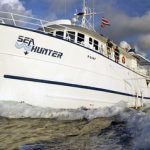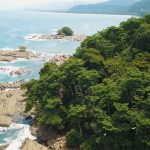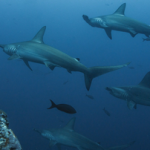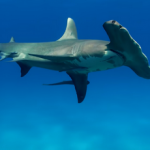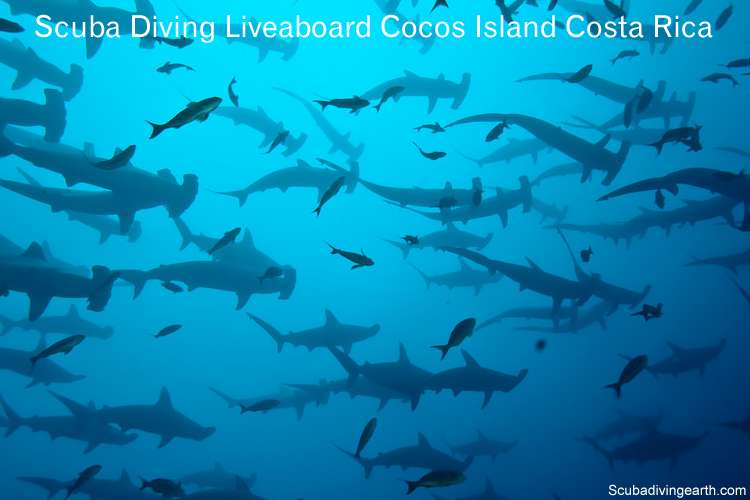
The only way to scuba dive the seas around Cocos Island and experience the hammerheads is by liveaboard
Diving Cocos Island is most scuba divers dream. Most scuba divers go to see the large populations of hammerheads there. Along with the other large populations of marine creatures.
Scuba diving Cocos Island Costa Rica can only be done from a liveaboard. To get there you need to fly to Costa Rica. Then it’s a 36 hour boat trip to Cocos Island from Puntarenas port. But if you love to dive with sharks, the trip is worthwhile. It’s for experienced and advanced divers only, due it its remote location of 530 kilometres (330 miles) off the coast of Costa Rica. The marine life there includes large numbers of hammerhead. But you will also see other shark species, including on occasion the whale shark, plus other marine creatures.
The best way to dive the Cocos Islands, Costa Rica is by a scuba diving liveaboard. You can check the latest and best deals on Cocos Islands liveaboards using the following window:
Where is Cocos Island?
Cocos Island is located in the Pacific Ocean roughly 530 kilometres (330 miles) off the coast of Costa Rica. The island itself is not allowed inhabitants, except for the twelve park rangers there. That means there are no dive centres.
There are no hotels or resorts either. That means the only way to scuba dive there is by liveaboard. Click this link if you you’re interested in finding out more about a scuba dive liveaboard trip to Cocos Island.
The waters around Cocos Island are deep with counter currents. These deep waters and rich seas are what attracts the marine life.
Cocos Island was declared a Costa Rican National Park by means of Executive Decree in 1978. Plus Cocos Island National Park was designated a World Heritage Site by UNESCO in 1997. Cocos Island is the only island in the tropical eastern Pacific with a tropical rain forest.
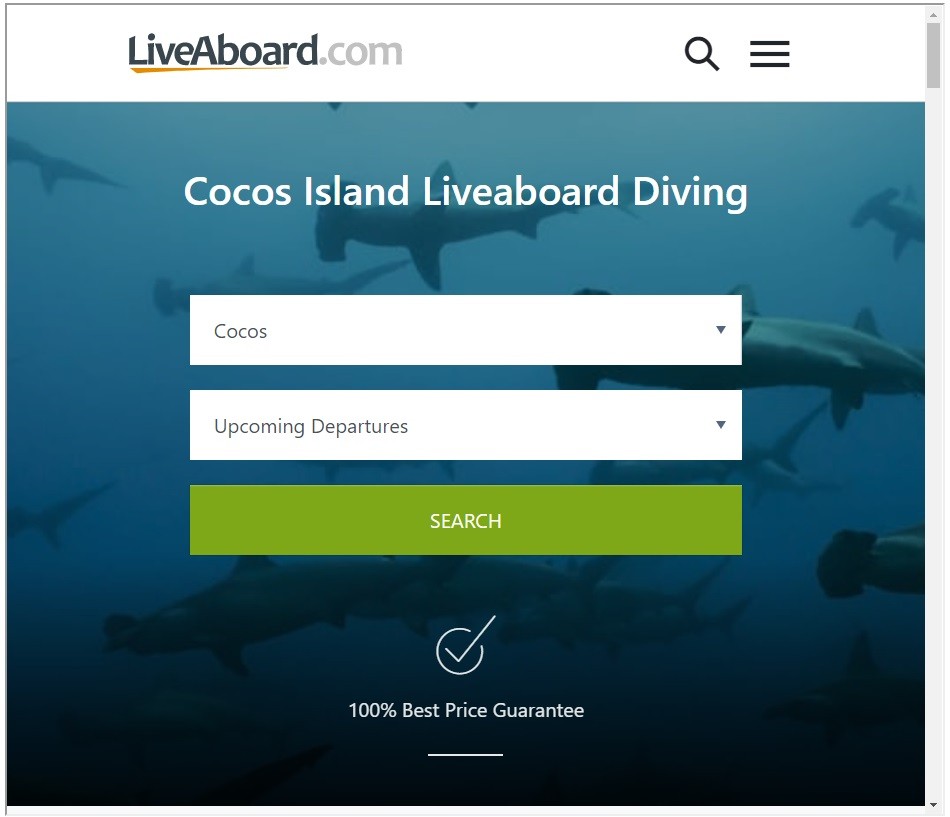
A quote from UNESCO website:
“The underwater world of the national park has become famous due to the attraction it holds for divers, who rate it as one of the best places in the world to view large pelagic species such as sharks, rays, tuna and dolphins.”
It was even short-listed in 2009 as a candidate to be declared one of the new seven wonders of nature. It was also included in the top ten dive sites in the world by as Jacques Cousteau.
The island covers an area of 2,400 hectares. The island itself known as “Isla del Coco”, but also known as “Treasure Island”, is the only landmark of the vast submarine Cocos Range. Only scuba divers get to see the other submerged seamounts. It is this that is the main focus for Cocos Island, especially for scuba divers.
The underwater world not only has a diverse marine ecosystem which is mostly pelagic, but also has the most diverse coral reefs of the entire Eastern Tropical Pacific.
How to get to Cocos Island Costa Rica
The best way to reach Cocos Island is from mainland Costa Rica. Most of the major airlines fly to Costa Rica’s main airport in San José’s Juan Santamaría International Airport. These would include from the UK British Airways and American Airlines. From the United States and Canada you can fly with American Airlines, Continental, Delta and Air Canada to name a few.
You will then need to board a liveaboard boat, which is done from the Port of Puntarenas. You are advised to arrange a stay at a hotel both before and after your liveaboard trip. The crew of the liveaboard will collect you from your hotel of choice. There are many hotels in San José to choose from.
It is then a 36 hour trip to Cocos Island and on the way to the island there’s no diving or snorkeling. There are no islands on the trip there either, unless you visit between January and June. If you visit at this time you can also visit Cano Island too.
The liveaboard dive boats are prepared for this long trip, as they have plenty of on board entertainment for scuba divers to enjoy.
Cano Island is much closer to the coast of Costa Rica. Around this island there’s much more colour in the form of coral reefs. There’s also a greater variety of tropical reef fish too. But there are less pelagic fish, although you are still likely to encounter sharks, rays and turtles. Plus you may be lucky to witness sightings of dolphins and whales too.
What level of scuba divers can dive Cocos Island?
Due to the remote location of Cocos Island and the currents that are experienced, divers need to be advanced certified scuba divers.
You may be able to dive the Cocos Island as an Open Water Diver, but you need to have at least 25 dives under your belt. But if you are considering to dive Cocos Island from a liveaboard as an Open Water scuba diver, make sure the diving experience you have includes drift diving experience.
But even with that said, if your diver certification is Open Water Diver, you will be limited to 18 metres (60 feet) depth, which for the waters around Cocos is not really deep enough. You want to be able to dive to at least 30 metres (100 feet), to really make the most of Cocos Island waters.
If you are unsure about whether you’ll be able to scuba dive, click this link to contact Dive The World and ask their friendly staff for help.
You will also need to be good on a boat. This is especially true in the rainy season, as the seas can get a bit rough at that time. If you are unsure, you may wish to take some medication for sea sickness.
Dive sites at Cocos Island Costa Rica
There are around 20 dive sites in total around Cocos Island. These include Dos Amigos (Grande and small), Manuelita, Bajo Alcyone and Dirty Rock.
Dive sites in a bit more detail:
Dos Amigos Grande and Small Cocos Island dive site
Two of the dive sites at Cocos Island include the Dos Amigos Grande and the Dos Amigos Small. Usually both of these sites are dived on the same dive.
The starting point of whether you begin at Dos Amigos Grande or Small is current dependent.
Dos Amigos Grande is regarded as a reef dive where the visibility ranges from 20-25 metres (65-80 feet). The notable feature is the huge archway there that you can swim through.
At both sites you’ll encounter Scalloped Hammerhead Sharks. But there are usually more hammerhead sharks at Dos Amigos Small than at Dos Amigos Grande.
The Dos Amigos Small dive site is a hammerhead cleaning station. The depth is from zero to 30 metres (100 feet).
At this dive site there are usually plenty of hammerheads to view. This is classed as a top dive site to most scuba divers who visit.
Dos Amigos Grande dive site video
Manuelita coral garden dive site Cocos Island
The Manuelita Coral Garden dive site is one of the dive sites around Cocos Island that is protected from the current or swells.
Due to the calm conditions, you will enjoy a beautiful colourful coral garden at a depth of between 6-21 metres (20-70 feet).
If you’re a scuba diver photography lover, this dive site is for you. There’s a huge abundance of coral fish that swim and hide in and amongst the various corals.
You are also likely to see whitetip and blacktip reef sharks, rays (including manta rays, marble rays and eagle rays), turtles, garden eels and you may even get to see the resident tiger sharks.
As with most dive sites around Cocos Island, you’re likely to also see hammerheads too.
But a treat for those night dive enthusiasts, this is probably the best night dive spot. At night you get to see large schools of whitetip sharks feeding on the coral reef dwellers.
Video of a night dive at Manuelita coral garden dive site Cocos Island
Whitetip reef sharks and black jacks hunting for their prey at Manuelita Coral Garden, Cocos Island (Costa Rica).
Bajo Alcyone dive site Cocos Island
The Bajo Alcyone dive site is located on the eastern side of Cocos Island. This reef was named after the expedition there by Jacques Coustea. As already mentioned, Cocos Island is in his top ten dive sites around the world.
The maximum depth on this dive is around 30 metres (100 feet). The visibility is usually around 20 metres (66 feet).
The dive at Bajo Alcyone starts by descending to an exposed seamount situated at between 30-40 metres (100-130 feet). There are usually mild to moderate currents running on the Bajo Alcyonedive site.
Due to the currents there, you’ll dive on an anchor line. The anchor line is for the purpose of reaching the seamount. Once you’ve descended down the anchor line and reached the seamount, you then swim towards the edge of the reef to watch the hammerheads.
You will need to find a rock to hold on to, as the current will sweep you away otherwise.
The main reason for diving the Bajo Alcyone dive site at Cocos Island is for the scalloped hammerhead shark interaction. But the hammerheads are not the only fish you’ll see there.
You are likely to see octopus and eels on the reef itself. Then you may also see marble rays, white tip sharks, eagle rays, turtles and tuna. Plus the endemic Cocos Barnacle Blenny.
A video of Bajo Alcyone Cocos Island which includes a whale shark sighting
Alcyone or Bajo Alcyone, this dive site was discovered and called by Commandant Cousteau and team mates while on expedition in Cocos Island aboard the legendary research ship Alcyone
Dirty Rock dive site Cocos Island
The depths at Dirty Rock range from around 6 metres (20 feet) to 39 metres (130 feet). But the average dive depth here is around 30 metres (100 feet). Dirt Rock is located at the western side of Cocos Island. Visibility is usually around 20 metres (66 feet).
It is a similar dive in terms of profile to Bajo Alcyone dive site.
Dirty Rock is probably the main reason for scuba divers to come to Cocos Island in the first place. This is due to the fact of the diverse marine life seen there.
This can include Scalloped Hammerhead sharks, white tips and black tips reef sharks, marble rays, eagle rays and mobula rays, jacks, turtles, dolphins, and even whale sharks are sighted there.
At Dirt Rock there’s no real need to go too deep to see the hammerheads, if that’s your reason for going there. You will dive down an anchor line. As you descend, you are more than likely to see the hammerheads on your descent. The initial descent will take you to a ledge at around 20 metres.
But to see the larger school of passing hammerheads you will need to descent further to around 25-30 metres (82-100 feet). This is to a cleaning station, where the hammerheads come to get cleaned of parasites and fungus by the resident black-nosed butterfly fish, also known as barberfish.
A video showing Dirty Rock cleaning station and some of the sea life at Cocos Island
This video is about Cocos Hammerhead Cleaning Station
Why there’s such an abundance of sea life at Cocos Island
In the BBC Earth video below narrator Sir David Attenborough explains about Cocos Island. Cocos Island is an isolated seamount that rises up precipitously from the sea bed thousands of metres below.
This seamount of Cocos Island creates an oasis where life flourishes in the comparative empty ocean. Most of the fish around Cocos Island are permanent residents. You’ll see from the BBC Earth video below, these number in their thousands. Which is why Cocos Island is a scuba diver mecca.
The northern equatorial counter-current
The key factor that creates this oasis of life is the deep ocean currents. The currents that run along the ocean bed a few thousand metres below collide with the seamount’s flanks and are deflected upwards. In fact Cocos Island’s position is the first point of contact with the northern equatorial counter-current.
These upward currents bring with them nutrients from the depths. These nutrients are fed upon by plankton, which then become food for the many thousand of plankton feeders.
It’s the plankton feeders that then attracted larger fish species like yellow fin tuna. The plankton feeders are easy targets, which in turn attracts the sharks.
These sharks feed upon these shoals of fish too and they can number in their hundreds. Silky sharks in particular have been known to school up to 500 at a time, which prefer to predate on the injured fish around Cocos Island.
But then there’s the scalloped hammerheads, which are not there for the feeding. Hammerheads visit for the cleaning stations. Hammerheads have been numbered in their thousands at times. Following the last el nino year, which is associated with a band of warm ocean water that develops in the central and east-central equatorial Pacific, a rise in water temperatures caused many sharks to suffer from fungal infections.
At this time the number of hammerheads visiting Cocos Island and the hammerhead cleaning stations reached record levels.
Cocos Island video with hammerheads, silky sharks and yellow fin tuna
In the Pacific, a tiny island 300 miles away from the shore hides a giant mountain beneath the waves that forms a home for thousands of plankton feeding fish. These fish attract Tuna, and the Tuna attract thousands of Sharks. Watch this video to learn more about this fascinating food chain, and hear some weird but true facts about the visiting Hammerhead Sharks
When’s the best time to dive Cocos Island?
Cocos Island is probably one of the most remote places in the world served by a liveaboard. The climate there is mild and subtropical throughout the year.
There are two seasons around Cocos Island. These are the dry season and the wet season.
The dry season is generally between December and May each year. Whereas the rainy season begins in June and runs through to November each year. Of course in the rainy season you’ll encounter plenty of rain. Plus the seas can be quite rough at this time.
But of course it’s nature at its best. If you want to experience the best possible sightings of the hammerheads, have the best chance to see whale sharks and manta rays, this is the best time to go.
The reason for this is during the rainy season the rougher seas carry more plankton. The plankton creates the food chain, which attracts the big fish which feed on it. But the plankton will affect the visibility.
July is said to be the best month to scuba dive the national park around Cocos Island. During July you will experience quite varied sea conditions, so you’d better have good sea legs. But July is when the hammerheads and the whale sharks are at their peak.
For those with not so good sea legs
If your sea legs aren’t so good and you’d prefer to avoid the rainy season and the rough seas, you will still have a great experience scuba diving there.
Most of the large pelagics, and in particular the hammerhead sharks are still seen at this time, but not in the same numbers as they are in the rainy season.
What you will see at Cocos Island Costa Rica
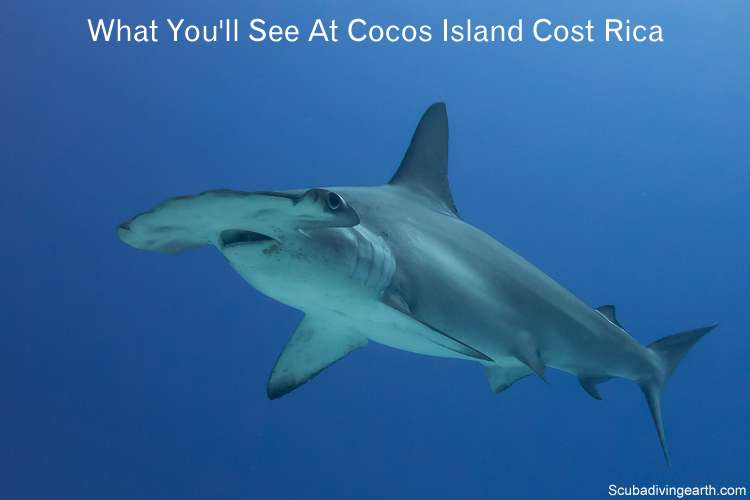
The main reason for scuba diving Cocos Island is for the abundant marine life. The variety includes the following:
- Scalloped hammerhead sharks – sometimes in their thousands.
- Tiger sharks.
- Wahoo.
- Manta rays.
- Eagle rays.
- Marble rays.
- White tip sharks.
- Silky Sharks – sometimes up to 500 at a time.
- Milkfish.
- Giant moray eels.
- Grouper.
- Yellow fin tunas.
- Whale sharks.
- Turtles.
- Whales and dolphins, including humpback whales.
Scuba diving conditions including the water temperature around Cocos Island
The water temperature ranges from 24-30°C (75-86°F). It is advisable to take a 5mm wetsuit with you, as the water temperature can change dramatically, dropping by up to 6°C (43°F) due to thermoclines. Some advise to take gloves and boots too in order to avoid getting cold.
The visibility can range between 10 to 30 metres ( 30-100 feet). The visibility does depend on the time of year and the amount of plankton in the water.
The depth of dives ranges from 10 metres to 40 metres (30-130 feet).
The Scuba diving liveaboards venturing to Cocos Island Costa Rica
There are four good liveaboard boats that operate out of Port of Puntarenas.
- MV Sea Hunter – 36 metres (119 feet) with a max capacity of 20 scuba divers.
- MV Argo – 39 metres (129 feet) with a max capacity of 16 scuba divers.
- Okeanos Aggressor II – 37 metres (122 feet) with a max capacity of 22 scuba divers.
- Okeanos Aggressor I – 34 metres (112 feet) with a max capacity of 22 scuba divers.
If you want to visit Cocos Islands on a liveaboard – Click this link to find out more or to book your trip.
Here’s a bit more information about the most popular of all the liveaboard boats:
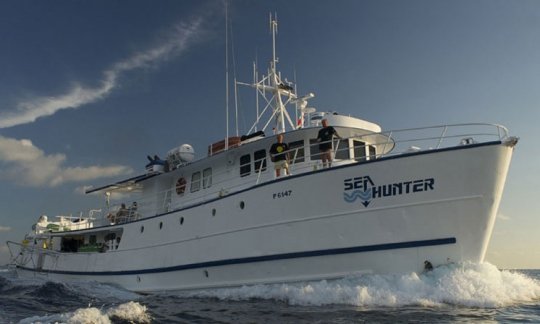
MV Sea Hunter – Cocos Island Costa Rica liveaboard – Middle budget
The MV Sea Hunter was a part of the original pioneers of scuba diving in Cocos.
Details of MV Sea Hunter Cocos Island Costa Rica liveaboard
- 36 Metres (119 feet) steel mono-hulled liveaboard boat. With a capacity of 20 scuba divers.
- Has 4 stabilisers, which are lowered into the water from fixed outriggers. This makes it and amazingly stable dive platform with hardly any rocking motion at sea.
- Specializes in cruises around Cocos Island.
- Max number of dives on 10 night trip is 24.
- All cabins with private bathrooms and air conditioning.
- Free on board laundry.
- Personal diver locator, which are fitted to all dives due to the remote destination.
- Dedicated restaurant and computer room.
- Large air conditioned lounge is where the full range of entertainment facilities are enjoyed
- Dedicated air-conditioned restaurant and a sundeck.
- Free nitrox diving on dive trips.
- The MV Sea Hunter is also equipped to service rebreathers and technical divers.
- You dive from spacious and covered fiberglass skiffs, which are fitted with twin engines for added safety.
- Minimum of a 10 day trip.
- Departs from Punta Arenas.
- International and local cuisine is served with the occasional BBQ.
- Meals consist of breakfast, lunch and dinner with snacks in-between.
- Coffee, tea, drinking water, soft drinks and a beer after your last dive are provided free of charge.
- Additional beer and wine can be purchased at an additional cost.
To book the MV Sea Hunter, which is the top Cocos Island Costa Rica liveaboard – Click this link to find out more or to book your trip.
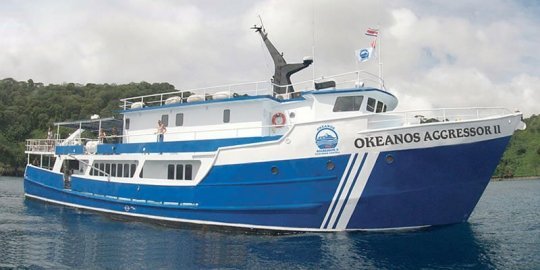
Okeanos Aggressor II – Cocos Island liveaboard budget option
Although the Okeanos Aggressor II is the Cocos Island liveaboard budget option, all drinks are complimentary on this dive boat. With this liveaboard you have the option of scuba diving either Cocos Island, Guanacaste & Bat Islands or Cano Island.
Details of Okeanos Aggressor II liveaboard
- 37 Metres (122 feet) steel mono-hulled liveaboard boat. With a maximum capacity of 22 scuba divers.
- Specializes in cruises around Cocos Island, Guanacaste & Bat Islands and Cano Island.
- All 11 cabins with private bathrooms and air conditioning. Also, they come with a hairdryer, bathrobe, towels and toiletries.
- Personal diver locator, which are fitted to all dives due to the remote destination.
- Max number of dives on 10 night trip is 24.
- Dedicated restaurant and computer room.
- Large air conditioned lounge is where the full range of entertainment facilities are enjoyed
- Dedicated air-conditioned restaurant and a sundeck.
- Nitrox is available on dive trips at an extra charge.
- There are two motorised tenders on board for diving from.
- Departs from Punta Arenas.
- International and local cuisine is served with the occasional BBQ.
- Meals consist of breakfast, lunch and dinner with snacks in-between.
- Coffee, tea, drinking water, soft drinks and alcoholic drinks are completely complimentary.
To book the Okeanos Aggressor II, which is the budget end liveaboard for Cocos Island – Click this link to find out more or to book your trip.
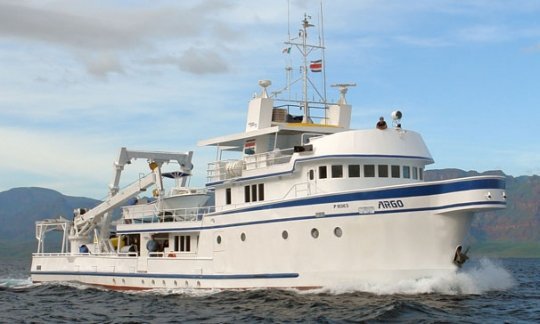
MV Argo – Cocos Island Costa Rica liveaboard high budget option
If you’re looking for that high budget liveaboard option and have a bit more to spend, the MV Argo liveaboard might be a better choice for you. Limited to just 16 scuba divers, this luxury vessel provides a more intimate scuba diving experience to Cocos Island.
MV Argo in more detail
- 39 Metres (129 feet) steel mono-hulled luxury liveaboard boat. Capacity of 16 scuba divers.
- Has a custom-built stabilizing system mounted on outriggers. This makes for peaceful sleeping on this cruise.
- The saloon features full audio-visual entertainment facilities to make the crossing pass more quickly.
- Chance to experience a once-in-a-lifetime dive up to a depth of 300 metre (985 feet) on the DeepSee Submersible, housed on MV Argo liveaboard.
- Specializes in cruises around Cocos Island, visiting the usual dives site listed above. But additionally Punta Maria shore visits can be arranged too.
- Max number of dives on 10 night trip is 24.
- All cabins are extra large and are either double or twin beds with private bathrooms and air conditioning.
- All suites have satellite phone communication as well as the ability to receive personal E-mail via the boat’s server and wifi system.
- There’s an upper deck study room, a sundeck and shaded area with sun chairs and mattresses.
- Free on board laundry service.
- Personal diver locator, which are fitted to all dives due to the remote destination.
- Large air conditioned lounge is where the full range of entertainment facilities are enjoyed.
- Free nitrox on dive trips.
- Dives are made from spacious and covered fiberglass skiffs, which are fitted with twin engines for added safety.
- Minimum of a 10 day trip.
- Departs from Punta Arenas.
- International and local cuisine is served on a buffet style.
- Meals consist of breakfast, lunch and dinner with snacks in-between.
- Coffee, tea, drinking water, soft drinks and a beer after your last dive are provided free of charge.
- Additional beer and wine can be purchased at an additional cost.
To book the MV Argo, which is the high budget Cocos Island Costa Rica liveaboard – Click this link to find out more or to book your trip.
Costa Rica’s Cocos Island dive liveaboards table
This list of Costa Rica’s Cocos Island liveaboards is in descending customer rating order, followed by Scuba Diving Luxury Rating (SDE Lux Rating, see below), so the liveaboards with the highest customer rating and the best SDE lux rating will be at the top of the list. If you want to change the list order, use the “Sort by” dropdown below.
| Discover Liveaboard | Customer Rating | SDE Lux Rating % | Flexible Booking | Dive Courses | Dietary Requirements | Nitrox | Gear Rental | |
|---|---|---|---|---|---|---|---|---|
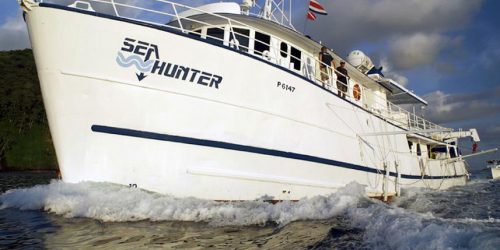 |
Review: MV Sea Hunter; Book: MV Sea Hunter | 9.2 | 79% | YES | YES | YES | YES | YES |
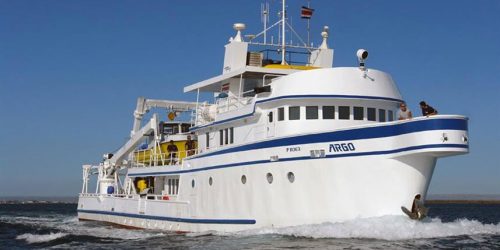 |
Review: MV Argo; Book: MV Argo | 8.9 | 81% | YES | YES | YES | YES | YES |
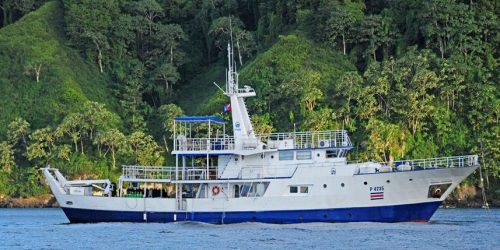 |
Review: MV Okeanos Aggressor I; Book: MV Okeanos Aggressor I | 8.8 | 67% | NO | YES | YES | YES | YES |
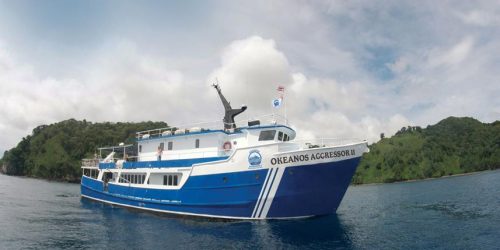 |
Review: MV Okeanos Aggressor II; Book: MV Okeanos Aggressor II | 8.7 | 69% | NO | YES | YES | YES | YES |
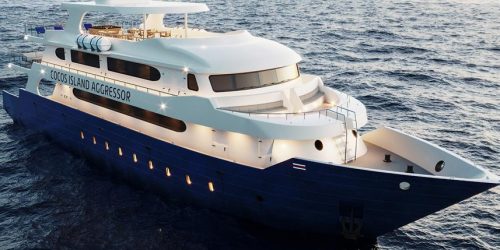 |
Review: MV Cocos Island Aggressor; Book: MV Cocos Island Aggressor | 0 | 58% | NO | YES | YES | YES | YES |
The Scuba Diving Earth Luxury Rating (SDE Lux Rating) is explained on each liveaboard review when you click the “Discover Liveaboard” link, and is my own Liveaboard Luxury Rating I’ve assigned to all liveaboards. Choosing between liveaboards is helped by customer scores, and if you get stuck choosing between two or three liveaboards, where each one has a high customer score out of 10, you can use the SDE Luxury Rating to help narrow down your choice.
Think about it like using Booking.com when searching for the best hotel. Booking.com also use a customer score where each customer rates hotels out of 10. This is similar to the liveaboard customer rating, which is also rated out of 10. But let’s say you only like to stay in hotels rated 8 and above on Booking.com, but you also want the hotel to have WIFI or parking, or to have a swimming pool etc. The features each hotel has is usually secondary to the score out of 10.
I hope you enjoyed this article about scuba diving liveaboard Cocos Island Costa Rica
I’d love to hear from you. Tell us about your adventures of diving and snorkeling, in the comments below. Please also share your photos. Either from your underwater cameras or videos from your waterproof Gopro’s!
If this article hasn’t answered all of your questions. If you have more questions either about snorkeling or scuba diving (or specifically about scuba diving liveaboard Cocos Island Costa Rica), please comment below with your questions.
There will also be many more articles about scuba diving (and snorkeling) for you to read and learn about these fabulous sports.
Have fun and be safe!

